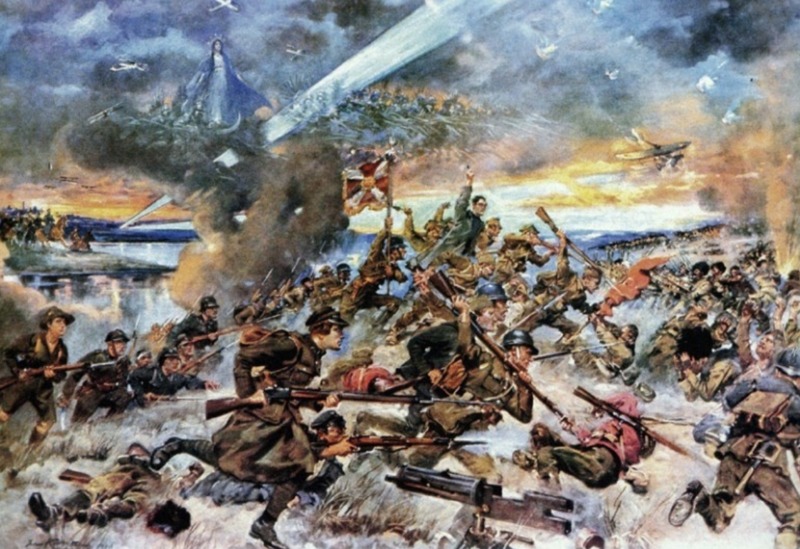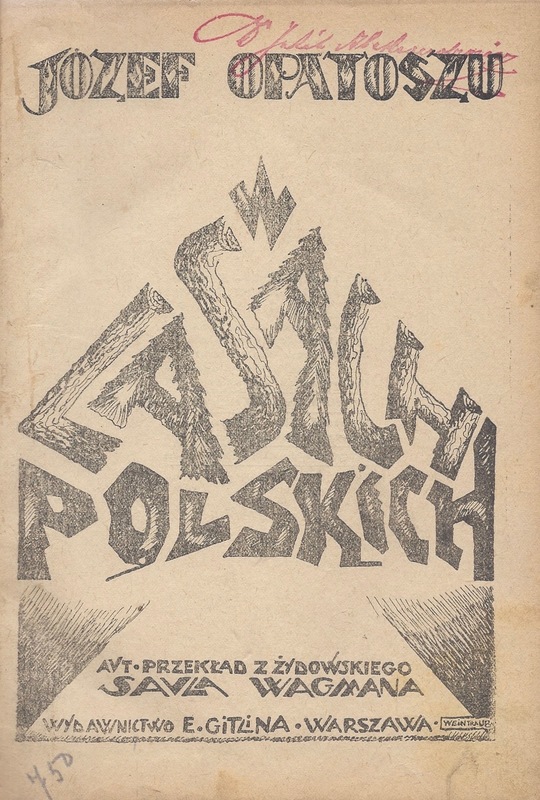The Arts
Mediums of entertainment such as films, literature, and art provide invaluable insight into a society’s culture. Sentiments regarding politics, social relations, and national development culminate to be conveyed artistically in the form of entertainment. This fundamental goal of the arts -- to entertain -- means that what is displayed in the films, paintings, and literature of a society parallels relatable cultural themes.
The arts and entertainment in interwar Poland evolved with political and cultural ideals present among Polish citizens. Subtle and explicit images within the arts reflect themes of patriotism and catholicism. The decision by creators of these images to include these themes to appeal to ordinary Polish citizens reveals the pertinent role that patriotism and catholicism played in Polish identity during the interwar period. The consequences of a religion constituting a portion of Polish identity included strong opposition to the potential inclusion of members of religious minorities in Polish nationality. Attempts by Polish Jews to assimilate into the Polish identity in the field of the arts were met with vociferous protest and censorship.
This 1936 film cover aims to intrigue an audience while presenting subtle patriotism. The text appears in red block letters, immediately drawing attention. The white clouds in the background combined with the color of the letters is reminiscent of the Polish flag. The poster is filled with mystery as we see a woman falling into an abyss and a hand with a knife that presumably cut the rope that another man is holding. We also see what appears to be the face of an earnest looking man in the background. This film is a crime and suspense comedy with themes of romance. It follows a Polish woman who goes mountain climbing with an American tourist (Ketty Brinx). The American’s husband Henry is determined to find Ms. Brinx, but ends up falling in love with the Polish woman. The fact that he chooses the Polish woman presents patriotic themes. The title also implies that the American is hiding something and therefore the Polish woman is more pure. The imagery presented on this cover conveys themes of masculinity and male saviorism. Henry ends up saving Ketty Brinx and the Polish woman by falling in love. The masculine imagery combined with the colors on the poster connects masculinity with Polish patriotism.
This 1930 painting by Jerzy Kossak presents a clear connection between Polish patriotism and Catholicism. The scene depicted is a reference to one of the most important battles in Polish history: The Battle of Warsaw in 1920. Just two years after regaining Polish statehood, the Polish army stopped the advancement of the Red Communist Russian army toward Western Europe, preventing another Russian invasion. Despite the odds, the Polish army used passion and bravery to defeat the red army. This painting presents a chaotic mix of colors and figures. In the midst of intertwined bodies and weapons, emerges the Polish flag, clearly conveying national pride. The soldiers present themes of masculinity and bravery that Kossak intends to associate with Polish identity.
Rising atop a cloud of smoke in the background appears The Virgin Mary in blue. Fire as well as the color blue symbolize rebirth and resurrection. This implies that like Christ, Poland is to rise from the ashes of the invasion and thrive more than ever before. There appears to be green and blue growing from the smoke, indicating that Poland is not only going to survive the battle, but it is also going to grow. Polish identity certainly grew from the patriotism that resulted from this battle. Bursts of yellow appear in the background beneath Mary suggesting the eternal life of Polish identity. The soldiers appear to be armed with passion and patriotic zeal to protect and preserve their Polish nationality.
This 1923 book cover reveals an attempt by parts of the Jewish community in Poland to assimilate into Polish culture. Jozef Opatoszu was a Polish Jewish writer who wrote his books in Yiddish. The cover art is avant garde style, presenting unconventional, modernist shapes. The words -- “W Lasach Polskich,” translates to “Tales of the Polish Forest” -- seem to be in the very basic shape of a house. This could be interpreted as the Jewish protagonists thinking of Poland as home. The book follows the story of “Jewish smugglers and horse thieves carrying out their trade on the Tzarist Russian-German border together with Poles, the novel is showing the Jewish rootedness in Poland” (Földvári Books, E. Gitlin). The book conveys the unity between some Jews and Poles.
However, deep divisions between Polish Jews and the right wing opposition was revealed in 1929 when Jonas Turkow tried to adapt this book into a film. The presented theme of Jews assimilating effectively into Polish society angered right wing religious Poles who accused the film of “deviating from religious laws,” (“The Lost World of Yiddish Films in Poland.” Culture.pl.). As a result, the film was heavily censored and did not resemble the original upon its release. This instance is revealing of the treatment of Polish Jews as an ethnic minority at large. The fact that the thought of Jewish assimilation into Polish identity catalyzed this level of protest indicates that there was a strong voice that actively hindered the inclusion of Jews into the Polish identity during the interwar period.


